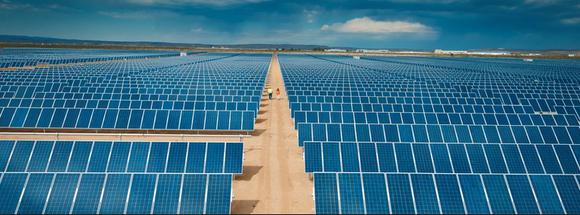India is Building the World’s Largest Solar Plant — And That’s Terrible News
ENERGY, 12 Jan 2015
Justin Loiseau, The Motley Fool – TRANSCEND Media Service
6 Jan 2015 – India is gearing up to build 20,000 MW of solar farms, including the world’s largest solar plant to date. But are India’s electricity eyes bigger than its solar stomach? Here’s why having the world’s biggest solar facility may not be the best option for India.
Move over, Texas
India is getting bigger faster. It’s home to 1.27 billion people (17% of the world’s population), it has the tenth largest economy in the world, and its annual GDP growth has jumped between 4.7% and 10.3% over the last decade.
As its economy and population expand, India is experiencing unprecedented energy demand. In 2000, the country consumed 376,000 GWh of electricity. In 2012 (most recent data), India ate up 869,000 GWh — a 130% increase. And while coal will continue to remain core to India’s electricity capacity expansion, renewable energies like solar will play an increasingly important role.
With the help of World Bank financing, India is preparing to build the world’s largest solar plant. Clocking in at 750 MW, the $1.3 billion project will be 36% larger than the current front-runner, First Solar‘s (NASDAQ: FSLR ) Topaz Power Plant in California.
httpv://www.youtube.com/watch?v=S-OAtHKwjdQ
Source: First Solar; Topaz Solar Farm – An Introduction.
Although it’s currently unclear which companies will be involved in the megasolar project’s construction, this isn’t India’s first rodeo. International solar companies have been making moves to enter India for a while. With sunny land, easy credit, and growing electricity demand, India may be the solar mecca.
So far, SunEdison, (NYSE: SUNE ) has emerged as a clear winner in India entry. In October, the solar company won 150 MW worth of project bids in Karnataka state and signed a Memorandum of Understanding, or MOU, with the Rajasthan government to build a whopping 5,000 MW of solar projects in the state. Each solar farm is expected to clock in at over 500 MW, making this one of the most massively scaled solar initiatives ever undertaken.
Size Matters
Unfortunately, large scale solar projects aren’t exactly what India needs. Yes, the country is taking steps toward energy independence. But India is creating the world’s largest solar project not because it’s the best option, but because it’s the only way it can operate. Decentralized power is a bureaucratic and infrastructure nightmare in the country, and big projects like this are often the only hope MOUs ever have of reaching fruition.
To give an example, the Indian government previously outlined a plan for 100% village electrification by 2007. Since 70% of India’s population is rural, a plan like that is a big deal. Yet a 2012 survey estimated that just 80% of rural households were connected to the grid. Even more telling, a 2011 Census report revealed that just 55% of rural homes use electricity as their main lighting source, evidence that a connection often isn’t enough.
Utilities commonly cut off electricity delivery (“load shedding”) to avoid bigger issues. In Maharashtra state, one of India’s most industrial and populous (Mumbai city of Slumdog Millionaire is here), a utility that delivered power without any issues in 1998-1999 reported 2002-2003 load shedding that cut demand by 20%. In most states, Indians enjoy just 8-12 hours of electricity use per day.
Grow up, India
India is undergoing severe growing pains, and its electricity sector is no different. While that represents incredible opportunity for solar power producers like SunEdison, an MOU signature isn’t always enough. International solar companies will have to work hard to ensure that their enormous-sized agreements are palpable for everyone from politicians to power companies to paupers, and that their own contributions coincide with a realistic and grounded electrification strategy for India.
_____________________
Justin Loiseau – Energy and Macroeconomic Specialist keeping investors up to date with macro news, utilities, and good companies doing good things.
DISCLAIMER: The statements, views and opinions expressed in pieces republished here are solely those of the authors and do not necessarily represent those of TMS. In accordance with title 17 U.S.C. section 107, this material is distributed without profit to those who have expressed a prior interest in receiving the included information for research and educational purposes. TMS has no affiliation whatsoever with the originator of this article nor is TMS endorsed or sponsored by the originator. “GO TO ORIGINAL” links are provided as a convenience to our readers and allow for verification of authenticity. However, as originating pages are often updated by their originating host sites, the versions posted may not match the versions our readers view when clicking the “GO TO ORIGINAL” links. This site contains copyrighted material the use of which has not always been specifically authorized by the copyright owner. We are making such material available in our efforts to advance understanding of environmental, political, human rights, economic, democracy, scientific, and social justice issues, etc. We believe this constitutes a ‘fair use’ of any such copyrighted material as provided for in section 107 of the US Copyright Law. In accordance with Title 17 U.S.C. Section 107, the material on this site is distributed without profit to those who have expressed a prior interest in receiving the included information for research and educational purposes. For more information go to: http://www.law.cornell.edu/uscode/17/107.shtml. If you wish to use copyrighted material from this site for purposes of your own that go beyond ‘fair use’, you must obtain permission from the copyright owner.
